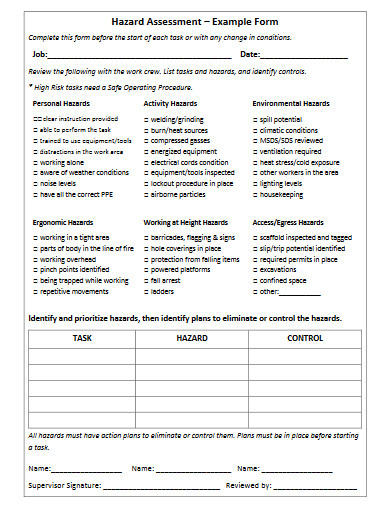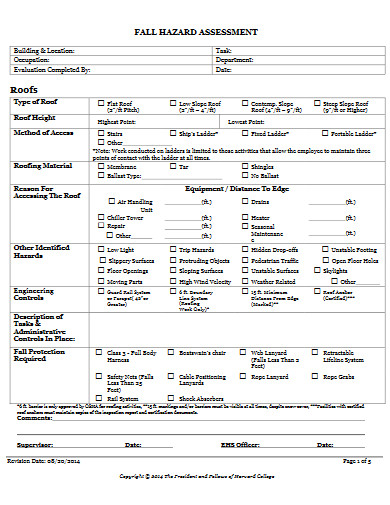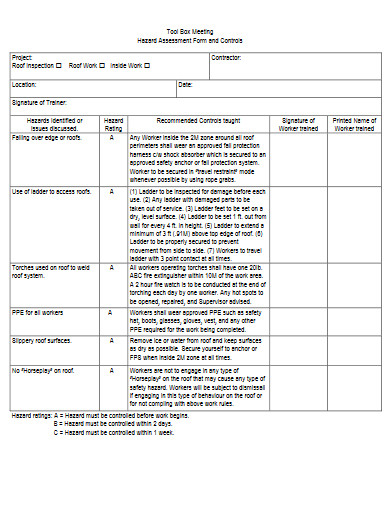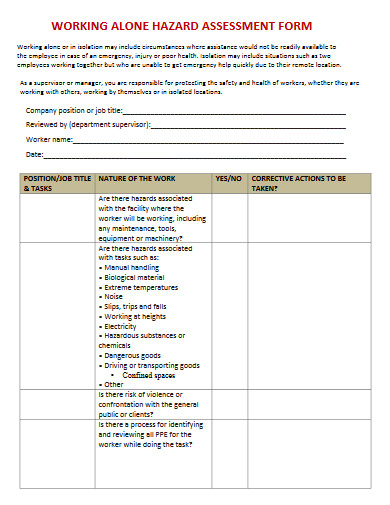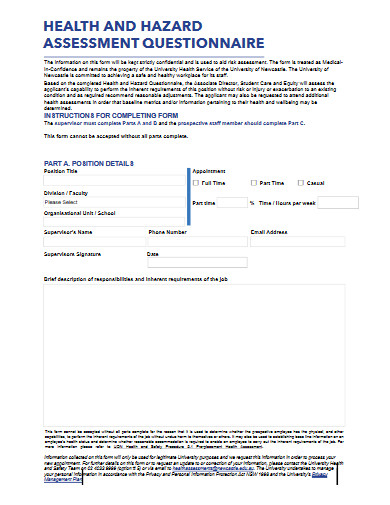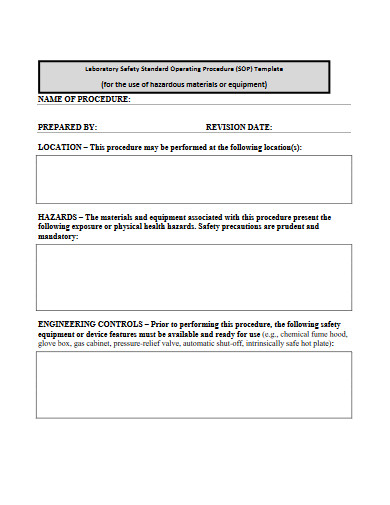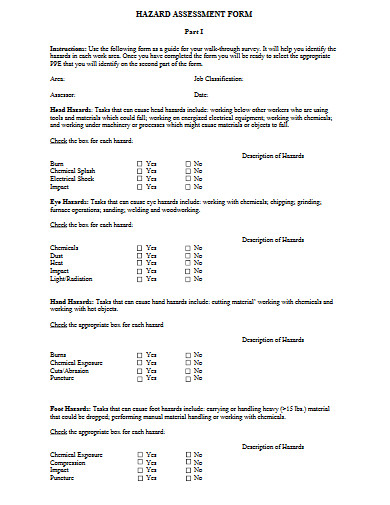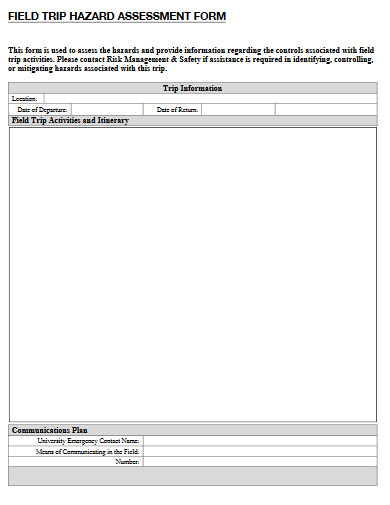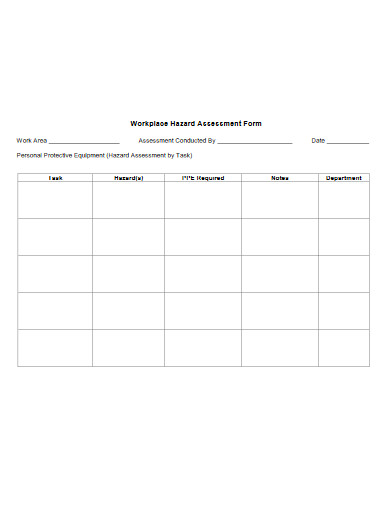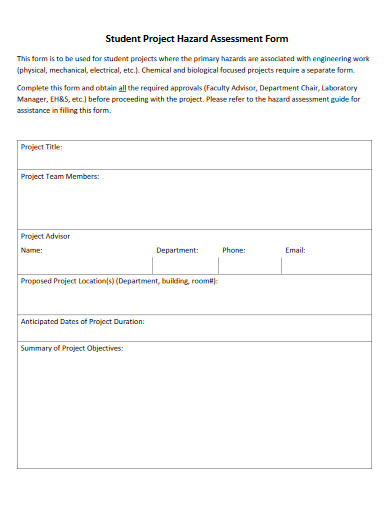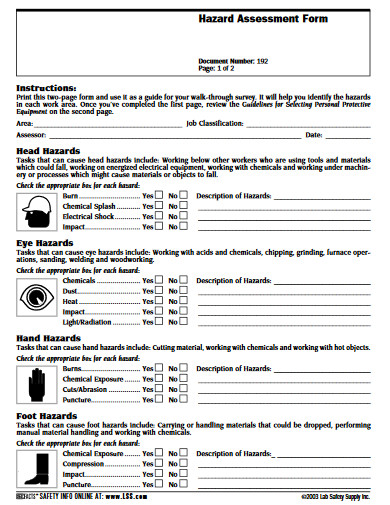10+ Printable Eviction Notice Form Examples to Download
If you think only heavy-duty jobs are prone to dangers and hazards, that’s where you’re wrong. Unfortunately, even when you’re just sitting on your office table while preparing a business proposal presentation, things can get wrong. Your computer might explode due to unforeseen technical issues, you might trip over your wires and break an ankle, or the overhead ceiling can collapse on you. This is not to raise unnecessary anxiety but to incite awareness that regular hazard check-ups are crucial. Accomplish the task with a reliable hazard assessment form. It provides a comprehensive list of hazards that you can examine and fix to avoid injuries and accidents. Take a look at our display below and read our article about this tool.
10+ Hazard Assessment Form Examples
1. Hazard Assessment Form Example
2. Fall Hazard Assessment Form
3. Hazard Assessment Form
4. Working Alone Hazard Assessment Form
5. Hazard Assessment Questionnaire Form
6. Laboratory Hazard Assessment Form
7. Hazard Assessment Form in PDF
8. Field Trip Hazard Assessment Form
9. Workplace Hazard Assessment Form
10. Student Project Hazard Assessment Form
11. Basic Hazard Assessment Form
What Is a Hazard Assessment Form?
A hazard assessment form is a tool used by safety evaluators in determining the different sources of potential risks by taking a close examination of a workplace’s processes, activities, and conditions. This is an important part of any business or industrial operations to check if there’s a need for process changes or reformation to promote a healthy and accident-free workplace for the workers, civilians near the area, and the environment surrounding them.
Different Workplace Hazards
According to the US Department of Labors’ Occupational Safety and Health Administration (OSHA), 5,250 employees died during their working hours in 2018. This data means that, on average, there are approximately 14 deaths in the workplace daily. A significant percentage of these workers are in the construction industry. The deaths were mostly involved with what OSHA dubbed as the “Fatal Four”: falls, struck by an object, electrocutions, and caught-in (trapped between heavy objects or equipment).
These grim incidents are sudden and unexpected. But the chances of them happening can be significantly diminished by identifying the risks early on. Here are the different types of workplace hazards that you should look out for:
1. Chemical Hazards – these are present in workplaces that operate with various chemicals. There might be substances that can cause physical and health harms as well as fires and explosions.
2. Physical Hazards – these are hazards that can harm people, whether they’re in contact with it or not. These include heights, noise, temperature, and radiation, among others.
3. Biological Hazards – these are hazards that result from closely working with humans and animals such as hospitals or poultry farms. Bodily fluids (e.g., blood, saliva. etc.), wastes, and insects might cause diseases that can cause infectious diseases.
4. Safety Hazards – these are hazards that, when not fixed, might cause minor to severe accidents. These include slippery floors, electrical wirings, and mechanical malfunctions.
5. Psychosocial Hazards – while all others cause physical harm, these hazards address the risks to a person’s mental health, such as abuse, harassment, and violence.
6. Ergonomic Hazards – ergonomic hazards are hard to spot because they don’t show immediate effects or harm. These are repetitive work practices that might cause lasting harm to a person’s body. An example of this would be faulty machine handling that can strain the muscles and the bones.
How to Create a Hazard Assessment Form
To help you set up your hazard assessment form, follow the tips below:
1. Identify What You Will Assess
Your assessment should include a description of what you’re assessing for immediate identification. Doing so helps the evaluator get a good glimpse of what the structure or process is all about. If you’re making an activity hazard analysis form, provide a section of fill-in-the-blanks to determine the activity’s details. If it’s a workplace assessment form, describe the nature of the job and the number of people working in that space. This gives you an accurate picture of your assessment area and will help you identify the rest of your form’s details.
2. Set the Safety Criteria
Before you can identify which factors of the event, structure, or activity might be hazardous, you need to have the right criteria first. You can have your own list of fact-based criteria or refer to government-sanctioned standards to determine what’s considered safe and what’s not. Refer to your description and provide a standard fitting level on what you’re going to assess. If you’re making a construction safety risk assessment form, there are many factors that you need to consider, such as the proper use of Personal Protective Equipment (PPE) and fall risk identification, among others. If you want to examine this list during the evaluation thoroughly, make a risk assessment checklist.
3. Determine the Different Hazards
Out of your set criteria checklist, it’s time to determine what might the different hazard risks of that activity or environment. Provide a space on your assessment form where the evaluators can place their potential hazard observation throughout the process. This might be your form’s most important part, as this determines whether or not a group or company failed to meet the standards provided to them. The list of items on this part will be the basis of your assessment score (if there’s any) and what changes need to be done to make it all alright.
4. Impose Hazard Reduction Measures
It’s not enough to merely point out what’s wrong in a system. There needs to be a solution. Aside from having a section that lists down the different risk hazards, your form should also provide a space where there’s a need to address the problems through various hazard reduction measures. It is where the evaluator will write down suggestions for changes, replacement, and minor fixes to make the area a safe space for the workers to be in. This also makes their plan produce not only excellent results but also a safety one.
5. Assign Responsibilities and Deadline
Now that there are sections that identify the hazards with the necessary changes, allow the assigned personnel to be accountable for their responsibility. If a structure’s roofing is deemed unsafe by the assessor, those responsible for the job should take the initiative to fix it. This should be on your assessment form, so it’s easy to provide the different roles and identify them easily. Assign a deadline for the changes along the project’s timeline to encourage diligence and accountability.
FAQs
What is the difference between hazard assessment and risk assessment?
Hazard assessment is identifying what are the potential causes of harm while a risk assessment is determining the level of possibility that it might cause someone any inconvenience or injury.
How often should you perform hazard assessment?
According to the Health and Safety Executive, there are many instances where you can perform regular hazard assessments. You can have an assessment when there are new machines and procedures. You can also do a hazard assessment if there are new roles on the job. If you’ve observed that there are numerous sickness cases among your employees, you might need to check your system.
What are the steps in conducting a hazard assessment?
The following are the steps in hazard assessment:
1. Identifying hazards
2. Determining who will be affected
3. Examining the risks
4. Making a list of findings
5. Reviewing the results
Wherever you may be, your safety is always at risk. It’s essential to regularly examine your surroundings and identify which materials in your environment may harm you. While this doesn’t completely take the danger away, this diminishes the risk level to the lowest degree and put your mind at ease. Don’t bother making your assessment form from scratch and use any of our high-quality template options above. Download now!



